Culture
Karaikal Ammaiyar: The Devotee Whom Shiva Called 'Mother'
Vijay Rajmohan
Aug 16, 2020, 12:42 PM | Updated 12:42 PM IST
Save & read from anywhere!
Bookmark stories for easy access on any device or the Swarajya app.
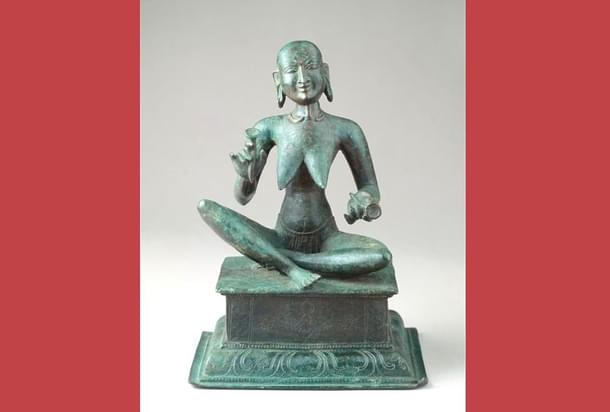
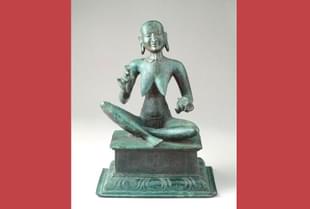
“அறிவானுந் தானே அறிவிப்பான் தானே
அறிவாய் அறிகின்றான் தானே - அறிகின்ற
மெய்ப்பொருளுந் தானே விரிசுடர்பார் ஆகாயம்
அப்பொருளுந் தானே அவன்.”
- காரைக்கால் அம்மையார்
“He is the one who realises, He is the one who reveals;
He is the knowledge as well as the Seer (who realizes Him as the knowledge);
He is the real truth that is known;
He is the flame that engulfs earth, vast Akash and all those things (beyond).”
— Karaikal Ammai
These verses were written 1,500 years ago by a housewife who lived in Karaikal, a seaside town in the eastern part of the Cauvery delta, part of the ancient Chola country.
The region abounds with ancient ports and towns like Chidambaram, Poompuhar, Nagapattinam, Tarangambadi (Tranquebar), and Karaikal.
Now, Karaikal is a small enclave and part of the Puducherry (Pondicherry) Union Territory.
Her real name was Punitavati. Her husband was a trader called Paramdutt (Tamil: Paramadattan). Paramadutt was from Nagapattinam, some 20 km away from Karaikal and both were ancient port towns of the mighty Cholas who once held sway over the South East Asian seas.
The trader community, of which both Paramdutt and Punitavati were part of, are called Chettiars.
They were eminent traders of the region and dominated the trading routes of the South east Asian nations for nearly two millennia, till Islamic naval forces, pirates and the European colonisers disrupted their trading routes and destroyed their dominance.
The Chettiars, till date, are ardent worshippers of Lord Shiva, and many of them are credited with refurbishing and preserving ancient shrines in Tamil Nadu.
While reading the above verse of Karaikal Ammaiyar, I’m reminded of the following lines from Purusha Sukta:
ōm sahasraśīrṣā puruṣaḥ sahasrākśaḥ sahasrapāt,
sa bhūmiṁ viśvato vṛtvā'tyatiṣṭaddaśāgulam.
[“Thousand-headed is the Purusha, thousand-eyed and thousand-legged. Enveloping the earth from all sides, He transcends it by ten fingers’ length.”]
puruṣa evedaṁ sarvam [“All this (manifestation) is the Purusha alone”]
Both these portray the vastness of the Supreme Being in different languages and using different terminologies at different points of time.
Here, and in other similar verses, this housewife narrates ancient truths told in the Vedas, Upanishads and other Sanskrit literature, in the local language (Tamil), in a high literary form.
She is credited with creating a new form of Tamil poetry called Anthathi, and is also a forerunner in depicting Shiva’s dance in Tamil hymns.
Her songs are full of devotion towards Lord Shiva, and many of them echo Advaitic principles and the underlying philosophies of the Saiva Siddhanta — a form/path of Shiva worship that exists in Tamil Nadu.
In one of her songs, she mentions about her education — ‘பிறந்து மொழிபயின்ற பின்னெல்லாம் காதல் சிறந்துநின் சேவடியே சேர்ந்தேன்’ [“After I was born and got education, I was filled with love for You (Shiva) and I surrendered myself at your feet].
She lovingly pleads to the Lord to take her out of the cycle of birth and death (samsara sagara) and surprisingly, her songs display the understanding of the philosophical and yogic concepts underlying the depiction (external form) of Lord Shiva and more importantly, Lord Nataraja.
She depicts Shiva as a flame, dancing with flame, and dancing in the cremation ground among the demons — all these are metaphors for various underlying philosophical concepts of the Shiva worship.
Lord Nataraja is depicted with flames surrounding Him and He holds a dancing flame while dancing in the space surrounded by flames.
The Saiva Siddhanta path advocated surrendering oneself to God (bhakti) with the understanding of the concepts behind the metaphors (bhakti with knowledge).
This kind of path is advocated by Thirumoolar, the revered Saivite Saint and author of Thirumandiram. This Thirumandiram, comprising of 3,000 verses on Shiva, and divided into various chapters called Tantra, form the basis of the Saiva Siddhanta of Tamil Nadu.
Thirumandiram is hailed as the ‘Sastra’ of Saiva Siddhantha.
Thirumoolar, the author and saint, who is said to have lived in Chidambaram and had the vision of the divine as dancing Shiva (Nataraja), points in one of his verses that many don’t understand the underlying concepts and take the metaphors literally.
Thus, it is clear that the ancients had the knowledge of the philosophies underlying the iconography.
In due course of time, the common people lost some of the knowledge about these metaphors.
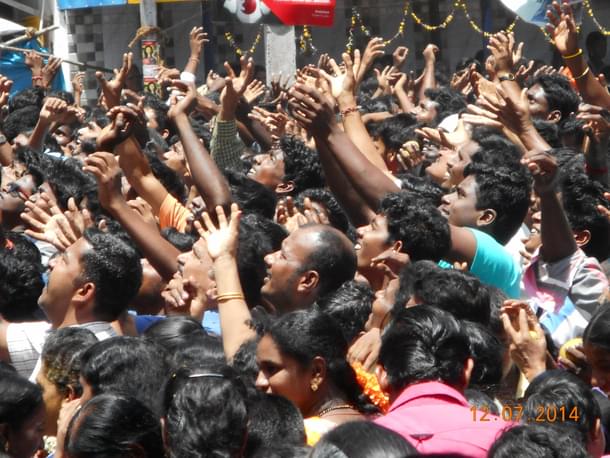
The poems of Karaikal Ammai reveal the knowledge that was ubiquitous in the society, in contrast with the anthropomorphic concept of God which prevailed in other parts of the world in those times.
She also refers to the concept of Shiva as 'Mahadeva' and uses a simple Tamil name for that, which can be understood by even a layman today — வானோர் பிரான் (Lord of the beings in Sky – vAnOr pirAn).
These words were later used by saints like Manickavasagar, who wrote masterpieces like Thiruvasagam extolling Lord Shiva.
She is a forerunner to most of them in this regard. She is venerated throughout Tamil Nadu as a great Saivite saint since those times.
In almost all Shiva temples of Tamil Nadu, one can see statues of the 63 Nayanmars (Saivite saints). She is one of the 63 Nayanmars.
Unlike other Nayanmars, who are depicted in the standing posture, she is always seated, recognizing her status as the ‘Mother’ (Amma).
There is an interesting story about why Punitavati, as she was called, came to be known as the 'Karaikal Ammaiyar' (Mother from Karaikal). The story goes like this — she and Paramadattan were happily married. One day, he sent her two mangoes.
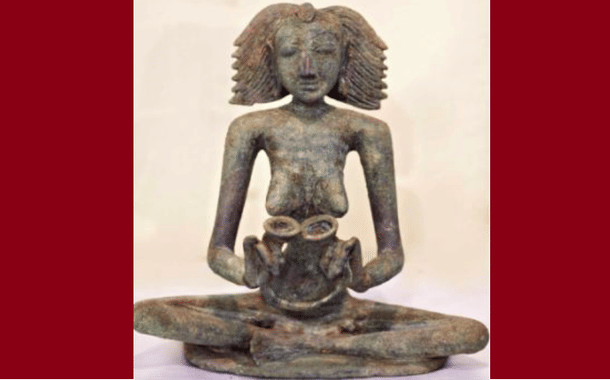
She is said to have gifted one mango to a Saivite ascetic who came for alms, and when her husband asked for the mango, she produced a mango by praying to Lord Shiva.
Her husband got unnerved by this and chooses to desert her.
When she meets him, he along with his second wife and child falls at her feet, recognising her as a saint. Thereafter, she prays to Lord Shiva to take away her youth and beauty so she can worship Him without getting bothered by others and thus gets a demonic form.
May be, that’s why she could visit distant Shiva temples of Tamil Nadu, including reaching the abode of Shiva (Mt Kailash).
She’s portrayed in an emaciated form with cymbals used for devotional singing.
As per the story, she travelled to Kailash all the way from Tamil Nadu. She walked on her head, lest her feet touch the sacred ground. When Parvati asked who this strange form was that looked demonic and walked on its head, Shiva is said to have called her as ‘Mother’ (Ammaiye) and mentioned to Parvati that she was the one who nourishes Him.
Interestingly, as per the same legend, when Lord Shiva calls her as 'Mother', she, in turn, calls Him as Appa (father). Since Lord Shiva Himself called her as Mother, she was called as Karaikal Ammaiyar.
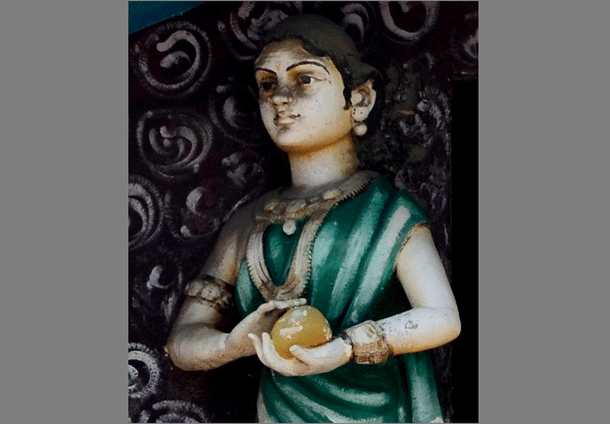
The traditional narrative of her life may contain Puranic elements, but what cannot be denied is her core historicity.
It is noteworthy to mention here that Punithavati a.k.a. Karaikal Ammaiyar was not part of the royalty. She was a commoner, a housewife. As many as 1,500 years ago, this society gave her a good education, understood her spiritual inclinations, allowed her to pursue a spiritual life, visit far off holy places, respected her knowledge, accepted her literary knowledge and innovations in composing hymns, elevated her to the status of a saint and celebrates her till date.
Her legend spread in the region and you find mention of her from Kerala (though the general assumption is that the Karakkalamma in the legend is that of a Nair woman, there is a view that the legend of 12 clans in Kerala overlaps with that of Tamil legendary figures and the memory was lost on the later generation of Malayalis and Tamils. Please see this and the contrasting view here.
Around the same time in other parts of the world, similar exceptional women in pagan societies were getting killed and their knowledge derided as that of arising from Satan.
There is no one to remember Hypatia, the exceptional Egyptian scholar woman, who hailed from a similar pagan culture and who was a Hellenistic Neoplatonist philosopher.
Hypatia was brutally tortured and killed at the age of 60.
In the town of Karaikal, the festival of Mango in commemoration of her producing mango out of thin air due to the grace of Lord Shiva, is celebrated till date (Mangani Thiruvizha).
Usually, this is celebrated around July every year, and during this festival, people throw mangoes on to the statue of Lord Shiva from rooftops and participants catch them and carry them as prasad.
Her legend remains in the society and her hymns are sung in temples and houses.
Every Indian should be proud of Karaikal Ammaiyar and also of the greatness of our society that recognised such exceptional women.
We should feel grateful for the unbroken tradition due to which we still recognise and celebrate such exceptional women.
An Indian Express story on the beautiful Chola Statue (11th Century) of her can be seen here. Some other verses of Karaikal Ammai are:
இடர்களையா ரேனும் எமக்கிரங்கா ரேனும்
படரும் நெறிபணியா ரேனும் - சுடருருவில்
என்பறாக் கோலத் தெரியாடும் எம்மானார்க்
கன்பறா தென்நெஞ் சவர்க்கு.
“Even if He does not end my misery, even if He does not take pity on me, even if He does not instruct me on the path (to Him), I will still love with all my heart, Him who dances in the crematorium with fire on His hand.”
வானத்தான் என்பாரும் என்கமற் றும்பர்கோன்
தானத்தான் என்பாரும் தாமென்க- ஞானத்தான்
முன்நஞ்சத் தாலிருண்ட மொய்யொளிசேர் கண்டத்தான்
என்நெஞ்சத் தானென்பன் யான்.
“Some say that He resides in the sky/heaven. Others say that He, as the Lord of the Devas, is in their land. But I know for certain that He with the black throat (Neelkanth) dwells in my heart in form of ‘knowledge’ (and He is mine)”
யானே தவமுடையேன் என்னெஞ்சே நன்னெஞ்சம்
யானே பிறப்பறுப்பான் எண்ணினேன்- யானே அக்
கைம்மா வுரிபோர்த்த கண்ணுதலான் வெண்ணீற்ற
அம்மானுக் காளாயி னேன்.
“Seems I have done penance in my previous birth to have been blessed with a good heart which longs to be freed from the cycle of birth and death. Glad that I have become a slave to the Three-eyed who has wrapped Himself with the hide of the elephant and is wearing the sacred ash.”
அருளே உலகெலாம் ஆள்விப்ப தீசன்
அருளே பிறப்பறுப்ப தானால்- அருளாலே
மெய்ப்பொருளை நோக்கும் விதியுடையேன் எஞ்ஞான்றும்
எப்பொருளும் ஆவ தெனக்கு.
“It is His Arul that rules over the world and it comes from Him; can end my birth. It is due to it that I was destined to understand the Truth. His Arul is everything for me.”
இனியோநாம் உய்ந்தோம் இறைவன் அருள்சேர்ந்தோம்
இனியோர் இடரில்லோம், நெஞ்சே - இனியோர்
வினைக்கடலை யாக்குவிக்கும் மீளாப் பிறவிக்
கனைக்கடலை நீந்தினோம் காண்.
“From now on, we stand redeemed; we are blessed with the grace
Of the Lord; o heart, no more will we suffer; we have now
Crossed the roaring ocean of interminable transmigration
Which mothers the sea of Karma.”
காண்பார்க்குங் காணலாந் தன்மையனே கைதொழுது
காண்பார்க்குங் காணலாங் காதலாற் - காண்பார்க்குச்
சோதியாய்ச் சிந்தையுளே தோன்றுமே தொல்லுலகுக்
காதியாய் நின்ற அரன்.
“Hara(n) who is the Primal Cause of the hoary world, can be
Beheld by them who fold their hands in adoration (surrender to Him)
And by those who love Him; (to such persons) He manifests
As light in their inner chamber of Chitta (Chittākāsha) “
அரனென்கோ நான்முகன் என்கோ அரிய
பரனென்கோ பண்புணர மாட்டேன் - முரண் அழியத்
தானவனைப் பாதத் தனிவிரலாற் செற்றானை
யானவனை எம்மானை இன்று.
“With His unique toe He quelled the might (of Ravana);
Shall I call Him Hara or the Four-faced
Or Hari? Alas, I canst not, this day,
Comprehend His (multifoliate) Godliness.”
அவனே இருசுடர் தீ ஆகாசம் ஆவான்
அவனே புவிபுனல் காற் றாவான் - அவனே
இயமான னாய்அட்ட மூர்த்தியுமாய் ஞான
மயனாகி நின்றானும் வந்து.
“He indeed becomes the two flames, the fire and the Akash too;
He, becomes earth, water and air; He indeed is
The soul and the eight forms (Ashta Moorti) ; truly it is He
Who abides as the Lord of knowledge (Gnana/Gyan).”
இங்கிருந்து சொல்லுவதென் எம்பெருமான் எண்ணாதே
எங்கும் பலிதிரியும் எத்திறமும் - பொங்கிரவில்
ஈமவனத் தாடுவதும் என்னுக்கென் றாராய்வோம்
நாமவனைக் காணலுற்ற ஞான்று.
“Our Lord, oblivious of His glory, goes abegging in sundry ways;
At night when darkness swells, He dances in the crematory.
Why does He do so ? This we will probe into that day when
We behold Him. Of what avail are our words now uttered here?”
[Note: Lord Shiva is depicted as Bikshatana, the mendicant/beggar who removed the vain glory of brahmins. The iconography is found in almost all Shiva temples built by Cholas possibly to denote that devotion to God and real knowledge is superior to rituals]
இவரைப் பொருளுணர மாட்டாதார் எல்லாம்
இவரை யிகழ்வதே கண்டீர் - இவர்தமது
பூக்கோல மேனிப் பொடிபூசி என்பணிந்த
பேய்க்கோலங் கண்டார் பிறர்.
“Others who behold His flower-red body bedaubed
With ash, decked with bones and looking like a ghoul’s,
Canst comprehend the truth about Him.
Are these to dispraise Him ? Lo, discern the truth.
Vijay Rajmohan is a civil servant, working with the Ministry of Agriculture & Farmers Welfare as Director (Digital Agriculture). Views are personal.





